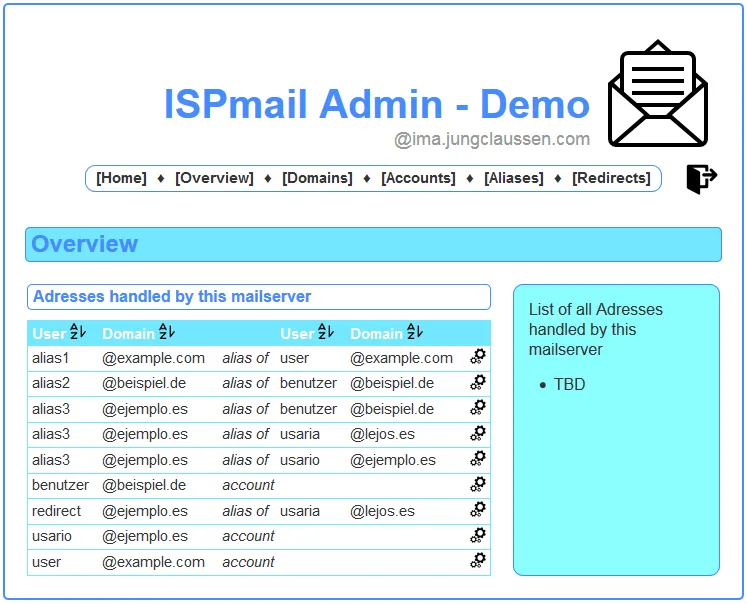Managing users, aliases and domains
Maybe you already know what you have to do to create mail domains and mail users. After all I tried to explain the database schema in the section that dealt with preparing the database. But if that wasn’t clear enough let me explain what you need to do to manage your mail accounts.
Using SQL queries
The following sections explain the changes and SQL queries you can use for common management tasks:
Create a new mail domain
Insert a new row into the virtual_domains table and set the “name” to the name of the new domain. (Do not forget to set up SPF and DKIM.)
INSERT INTO virtual_domains (name) VALUES ("example.org");Delete a mail domain
Delete the row from the virtual_domains table that has the right “name”. All aliases and users will automatically be deleted, too. However the mailboxes will stay on disk at /var/vmail/… and you need to delete them manually.
DELETE FROM virtual_domains where name='example.org';Create a mail user
Find out the “id” of the right domain from the virtual_domains table. The insert a new row into the virtual_users table. Set the domain_id to the value you just looked up in the virtual_domains table. Set the “email” field to the complete email address of the new user. Create a new password in a shell using the “dovecot pw -s BLF-CRYPT” command and insert the result into the “password” field.
INSERT INTO virtual_users (domain_id, email, password) VALUES (SELECT id FROM virtual_domains WHERE name='example.org'), 'john@example.org','{BLF-CRYPT}$2y$05$.We…';Change the password of a user
Find the row in the virtual_users table by looking for the right “email” field. Create a new password in a shell using the “dovecot pw -s BLF-CRYPT” command and insert the result into the “password” field.
UPDATE virtual_users SET password='{BLF-CRYPT}$2y$05$.We…' WHERE email='email@address';Delete a mail user
Find the row in the virtual_users table by looking for the right “email” field and delete it. The mailbox will stay on disk at /var/vmail/… and you need to delete it manually
DELETE FROM virtual_users WHERE email='john@example.org';Create a mail forwarding
You can forward emails from one (source) email to other addresses (destinations) – even outside of your mail server. Find out the “id” of the right domain (the part after the “@” of the source email address) from the virtual_domains table. Create a new row in the virtual_aliases table for each destination (if you have multiple destination addresses). Set the “source” field to the complete source email address. And set the “destination” field to the respective complete destination email address.
INSERT INTO virtual_aliases (domain_id, source, destination) VALUES ( (SELECT id FROM virtual_domains WHERE name='example.org'), 'melissa@example.org', 'juila@example.net');Delete a mail forwarding
Find all rows in the virtual_aliases table by looking for the right “source” email address. Remove all rows that you lead to “destination” addresses you don’t want to forward email to.
DELETE FROM virtual_aliases WHERE source='melissa@example.org';Web interfaces
If you don’t like using SQL queries to manage your mail server you may like to install a web-based management software. Several developers contributed web interfaces for earlier versions of this guide and they will probably still work because the database schema has not changed. Your experience with these projects, or links to further projects, is very welcome in the comments.
ISPmail Admin
Homepage: http://ima.jungclaussen.com/
Demo: http://ima.jungclaussen.com/demo/

ispmail-userctl
Christian G. has created a text-based program to help you manage your mail accounts. You may like it if you just want a little help adding accounts and setting passwords but not provide a full blown web interface.
You can find his Python script at Github.